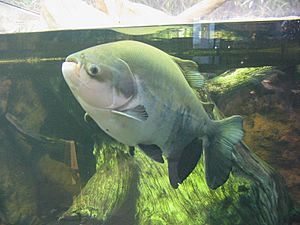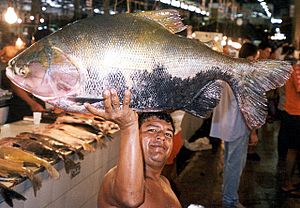Tambaqui facts for kids
Quick facts for kids TambaquiTemporal range: Miocene - recent
|
|
|---|---|
 |
|
| Scientific classification | |
| Synonyms | |
|
The tambaqui (Colossoma macropomum) is a very large freshwater fish. It belongs to the family Serrasalmidae, which also includes piranhas. This fish lives naturally in tropical South America. People also raise tambaqui in aquaculture (fish farms) and have introduced them to other places.
You might hear the tambaqui called by other names. These include black pacu, black-finned pacu, giant pacu, cachama, and gamitana. Sometimes, it's just called pacu, but that name is used for several similar fish species. The tambaqui is the only fish in its group, Colossoma.
Contents
Where Do Tambaqui Live?
The tambaqui is originally from rivers in South America. It lives in the Amazon and Orinoco river systems. In rivers with lots of nutrients, like the Madeira or Purus, you can find them everywhere. But in rivers with fewer nutrients, like the Rio Negro, they usually only live closer to the mouth of the river.
People raise tambaqui in fish farms in many places outside their natural home. Long ago, fossils of tambaqui were found in the Magdalena River. Today, if you see them there, it's because humans brought them.
What Does a Tambaqui Look Like?

The tambaqui is the heaviest fish of its kind in the Americas. It is also the second heaviest scaled freshwater fish in South America. The arapaima is the only one that is heavier.
Tambaqui can grow up to about 1.1 meters (3.6 feet) long. They can weigh as much as 44 kilograms (97 pounds). But most tambaqui are around 0.7 meters (2.3 feet) long. The biggest one caught with a fishing rod weighed 32.4 kilograms (71.4 pounds). After the flood season, about 10% of a tambaqui's weight is fat.
This fish looks a bit like a piranha. Young tambaqui are sometimes mistaken for piranhas. Tambaqui have a tall, flat body with big eyes. Their back is slightly curved. Unlike piranhas, tambaqui have molar-like teeth. These teeth are perfect for crushing plant seeds and nuts.
The bottom half of a tambaqui's body is usually black. The rest of its body is gray, yellowish, or olive. The exact color can change depending on where the fish lives. Fish from dark "blackwater" rivers are much darker than those from "whitewater" rivers. Their fins are black.
Tambaqui look similar to the pirapitinga (Piaractus brachypomus). However, pirapitinga have a rounder head and a smaller fin on their back. They also have different teeth. Sometimes, tambaqui and pirapitinga are bred together in fish farms. These mixed fish are called hybrids. It can be hard to tell them apart just by looking.
Tambaqui Life and Habits
Habitat, Reproduction, and Migration
Tambaqui usually live alone. But they travel in large schools when they migrate. During the time when they are not breeding, adult tambaqui stay in flooded forests. These forests are found along white, clear, and blackwater rivers. They live there for several months during the flood season.
As the water level drops, they move into the main river channels. They might also go into floodplain lakes. When the next flood season starts, large schools of tambaqui move into whitewater rivers. They spawn (lay their eggs) there between November and February. After spawning, the schools break up. The adults go back to the flooded forests. This pattern happens every year.
Baby tambaqui are found in whitewater rivers. Young tambaqui stay near water plants in floodplains and flooded forests all year. They only start the adult migration pattern when they are old enough to reproduce. This happens when they are about 60 centimeters (2 feet) long. Tambaqui can live for 40 years, and some may even live up to 65 years!
How Tambaqui Handle Their Environment
Tambaqui are very good at surviving in different conditions.
- Oxygen: If there isn't enough oxygen in the water, tambaqui can get oxygen from the air. They use special parts of their body, like their gills and swim bladder, to do this.
- Salt: Tambaqui are freshwater fish. But young tambaqui can live in slightly salty water if the salt level increases slowly. If the water gets too salty, they cannot survive. Too much salt also makes it hard for them to grow.
- pH: Tambaqui can handle changes in the water's pH level. They can survive even if the pH drops quite low. This helps them move between different types of rivers in the Amazon.
What Do Tambaqui Eat?
Tambaqui mostly eat fruits and seeds. They especially like those from trees and other plants. The amount and quality of these foods help the fish decide where to live. During the high-water season, fruits can make up most of their diet. One study found that during this time, 44% of their stomach content was fruits and seeds. They also eat zooplankton (tiny water animals) and wild rice.
During the low-water season, more tambaqui have empty stomachs. At this time, about 70% of what they eat is zooplankton. They also eat small amounts of insects, snails, shrimps, small fish, and decaying plants.
How Tambaqui Help Plants
Tambaqui are very important for spreading plant seeds. When fruit seeds fall into the water, tambaqui eat them. The fish then swim to another place and release the seeds. This is like how birds spread seeds. This helps many trees and plants grow after the floodwaters go down. Bigger and older tambaqui can spread seeds faster. A well-fed tambaqui can have over 1 kilogram (2.2 pounds) of seeds in its gut!
Tambaqui and Humans
Tambaqui meat is very popular. It sells for good prices in fish markets where it lives. People buy it fresh or frozen.
The number of wild tambaqui has gone down. This is because of overfishing, meaning too many fish are caught. Many of the fish caught today are young ones. For example, in Manaus, Brazil, the amount of tambaqui caught dropped a lot from the 1970s to the 1990s.
Because of this, tambaqui are now widely raised in aquaculture (fish farms). They can live in water with low oxygen and are very good at resisting diseases. In Brazil, tambaqui is one of the main fish raised on farms. This makes them important for the country's economy.
Sometimes, tambaqui are bred with Piaractus fish in farms. This creates hybrid fish that can live in colder water.
Tambaqui have also been introduced to other countries, like Thailand and Puerto Rico, for fish farming. Some have even been caught in parts of the United States. However, only in the warmest areas can they survive in the wild.
Young tambaqui, about 2-3 inches long, are sometimes sold as "vegetarian piranhas" in pet stores. But they grow very quickly and need a huge aquarium!
See also
 In Spanish: Cachama negra para niños
In Spanish: Cachama negra para niños


